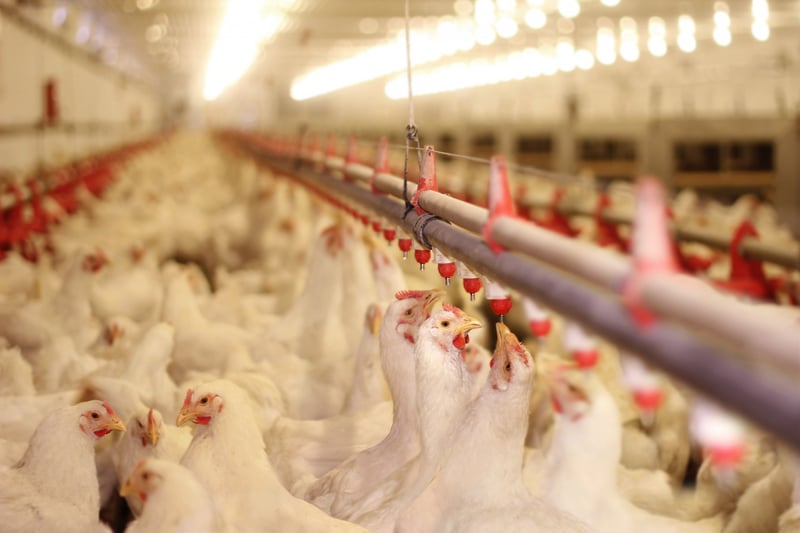
Health toll from factory farms to soar as demand for meat skyrockets
Press release
New research released today on World Health Day has laid bare the most damaging human health impacts linked to factory farming, and how these will only get worse as the demand for meat continues to grow in all corners of the world.
World Animal Protection’s latest report, The Hidden Health Impacts of Industrial Livestock Systems, exposes how governments around the world are turning a blind eye to the public health toll of factory farming as well as the suffering of billions of farmed animals.
By 2030, meat consumption is projected to grow 30% in Africa, 18% in the Asia Pacific, 12% in Latin America, 9% in North America and 0.4% in Europei. This skyrocketing demand sees billions of stressed animals mutilated and confined to cramped and barren cages or pens for their whole lives. Over 70% of the 80 billion land animals* farmed globally are raised and slaughtered within cruel factory farming systems each year – and in the US this figure is 99%ii.
The research builds on the concept of five pathways “through which food systems negatively affect our health”, outlined by the World Health Organization in their 2021 report Food Systems Delivering Better Healthiii. World Animal Protection details how these negative health impacts are directly linked to factory farming:
- Malnutrition and obesity: Factory farming systems have displaced local and sustainable food production. Land is used to plant crops to feed factory farmed animals, not people, undermining nutrition and food security. At the same time, high volumes of cheap meat produced out of factory farms is equating to excessive meat consumption - one of the four leading risk factors for chronic illnessiv.
- Superbugs and diseases: Three-quarters of the world’s antibiotics are used in farmed animals, either to prevent them getting sick, promote fast growth or treat disease – a practice driving the emergence of superbugs (antimicrobial resistant bacteria), which leaves us less able to fight infections. New research has found that 1.27 million people die each year from superbugsv, and it is estimated that by 2050 this will be the leading cause of death globallyvi. On top of this threat, factory farms squash stressed animals into tightly packed sheds, risking disease like swine flu or bird flu that can jump to humans.
- Foodborne illnesses: Cruel factory farming induces immense stressvii in animals, leaving them prone to bacteria or parasites that can cause foodborne illness in people, such as Salmonella. An estimated 35% of all foodborne diseases globally are linked to meat, dairy or eggsviii, which is costing lower income countries billions in USD each year in lost productivity and medical expensesix.
- Illnesses from environmental contamination: Factory farming produces large amounts of animal waste that pollutes our air with roughly 400 different harmful gases. Heavy metals like zinc are added to factory farmed animals’ diets and are excreted, contaminating waterways. This heavy metal contamination of foodx causes one million illnesses each year. Pesticides also contaminate our waterways, and more pesticides go to crops destined to feed animals suffering on factory farms than anywhere else. These impacts of air and water pollution are felt most by those living close to factory farms or animal feed production.
- Physical and mental impacts for workers: Within factory farming systems, physical and mental health impacts suffered by workers include; poor working conditions in meat slaughtering, processing and packaging facilities, physical injury and psychosocial and mental health issues.
Jacqueline Mills, Head of Farming, at World Animal Protection, said:
“Factory farms are making us sick. On the surface, factory farmed meat, fish and dairy products seem cheap, but they are costing us our health and governments trillions of dollars each year to mop up the damage.
“We need to break the cycle of suffering in our food system. Government support for cheap meat is equating to more animals being churned through cruel factory farms. Now is the time for governments to focus on better health outcomes for people, animals and the planet.
“There is no future for factory farms. We need a moratorium on factory farming. The food industry needs to embrace a humane and sustainable future where we consume predominantly plant-based diets, and remaining farmed animals are kept in genuinely high welfare systems where they can have good lives.”
Dr. Lian Thomas, Scientist at the International Livestock Research Institute (a CGIAR center) said:
“Industrial livestock farming requires the production of a high density of genetically homogenous animals, which leads to the quick spread of diseases – many of which can directly affect human health.
“The health of farmed animals and their environment must be a high priority for the public health sector. Sustainable food systems which promote good animal health and welfare, and environmental protection, will directly protect human health.”
Systemic shifts are needed to deliver the biggest health gains for our population. Some of those include re-orientating subsidies away from factory farming towards humane and sustainable practices, improving affordability of plant-based foods, and providing transition support for farmers no longer wishing to engage in factory farming.
In order to make these shifts, World Animal Protection is calling for governments around the world to impose a moratorium on factory farms and introduce and enforce higher farmed animal welfare standards.
-ENDS-
Notes to Editors
- Read the full report: The hidden health impacts of industrial livestock systems
- The latest FAO/OECD Agricultural Outlook forecasts production of beef, pork, poultry, and sheep meat is projected to grow 5.9%, 13.1%, 17.8% and 15.7% respectively by 2030.
- *Excludes the number of farmed fish
Factory farms are making us sick. On the surface, factory farmed meat, fish and dairy products seem cheap, but they are costing us our health and governments trillions of dollars each year to mop up the damage.